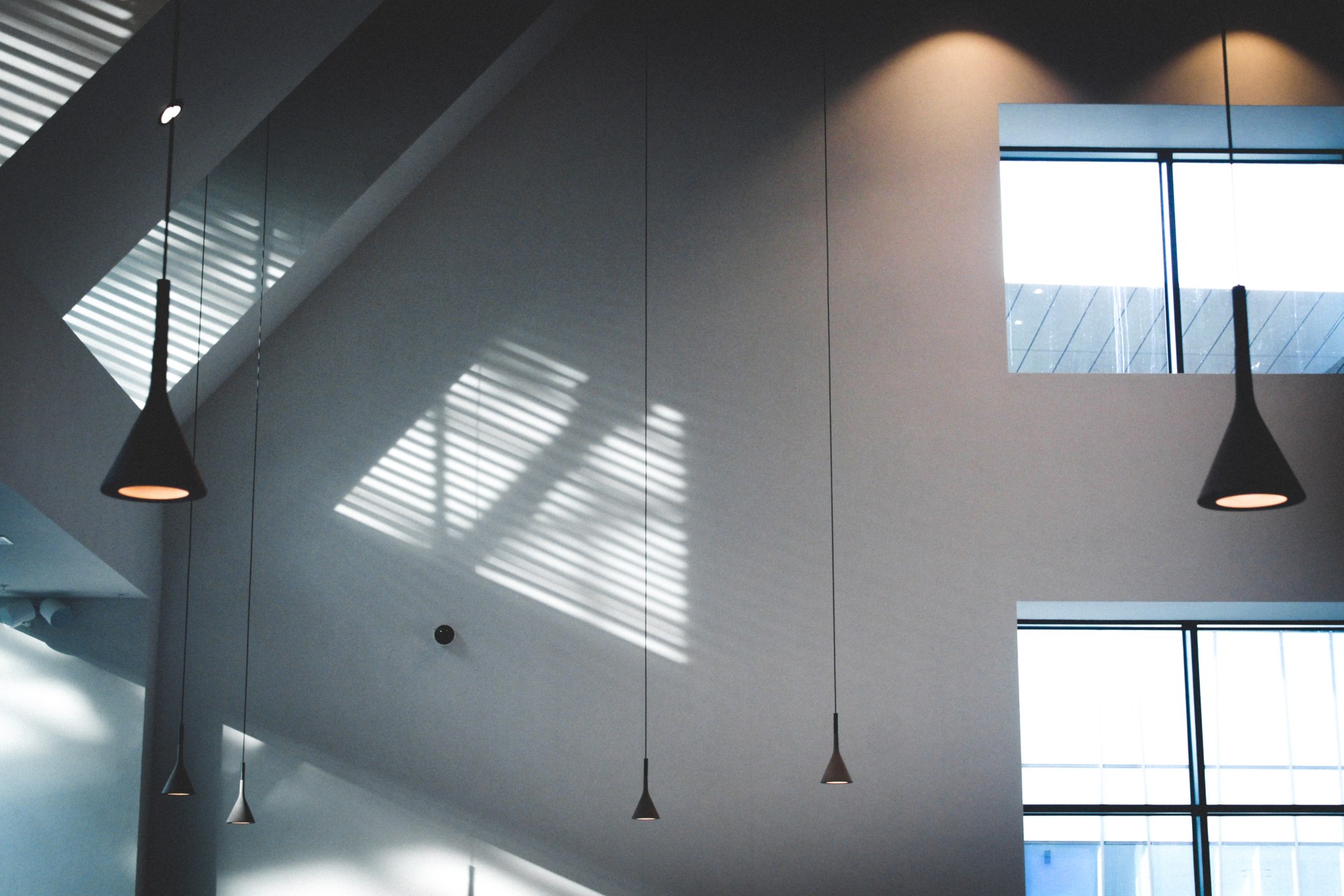
Ceilings are important parts of interior spaces in both form and function. They are likely the largest surface in the room, along with the floor. Unlike the floor, however, ceilings are generally a bit more plain. No hardwoods and no carpeting. We can’t throw rugs up there, and they can be tough to clean. They can also contribute to echo and reverberation.
For these reasons, some people choose to dig into the different kinds of unique ceiling styles out there. But, there is still an argument to be made for conventional ceiling design. It may not be as flashy as a coffered ceiling or one with exposed beams, but it can look great. It can also be the best particular choice for your unique room.
What is a Conventional Ceiling Design?
A conventional ceiling is probably exactly what you are thinking of when you hear the term. It’s a flat, finished surface, usually 8-10 feet off the ground. Most commonly, they are constructed of either drywall or plaster. It’s the kind of ceiling most of us have in our homes. The finish may vary, but the design and materials are usually the same.
Advantages of Conventional Ceiling Design
Some of the biggest advantages of using conventional ceilings are the reasons they are so popular.
First off, they are usually made of drywall in modern homes. This material is lightweight, inexpensive, and easy to work with. If you need to make any repairs, they are easy to hide. Even if you’ve got to replace an entire sheet, you can affordably replace it in an unnoticeable way.
Secondly, it looks great and lends itself well to many different types of design. A large overhead space that mirrors the floor below it is great for framing the interior design of the room. It’s also versatile when it comes to available finishes.
Conventional ceilings can even provide some acoustic benefits. Rooms with high ceilings are prone to echo and reverberation problems. The parallel walls reflect sound waves that traverse large expanses unimpeded. Going with a lower ceiling will solve some of these sonic problems.
Disadvantages of Conventional Ceiling Design
On the other hand, going with a conventional ceiling design does come with some drawbacks. Namely, they can feel somewhat dull. Large, flat spaces don’t command a whole lot of attention. In a world where designers have grand ideas, conventional ceilings can feel underwhelming. Not only that, but they can make the space feel cramped. When compared to vaulted ceilings and coffered ceilings, these low, flat designs can make the space seem smaller. The way to avoid these downsides is to give it a great finish.
Available Options in Conventional Ceiling Design
Many types of ceiling designs provide visual punch through their varied ceiling materials or surfaces. Since conventional ceilings are flat, we get visual interest from the paint or finish.
Flat Finishes
Many people choose to simply paint their flat ceiling. It can be very effective in modern design. Painted flat ceilings also deliver the benefit of easy cleaning. Whether doing your daily dusting or a deeper clean, this is the easiest finish to maintain. There are no nooks or crannies for dust to hide, and interior paints can be wiped without risk of damage.
Some people have even started using artwork directly on their conventional ceilings. Modern technology now allows us to print images onto canvas or membrane materials that stretch to fill the ceiling. Want a tree canopy with blue sky overhead? You can have it. Want something more abstract? That’s doable too. It’s an interesting new option but isn’t incredibly DIY friendly.
If you’re considering conventional ceiling finishes, you can do it yourself. Adding texture is a popular practice.
Textured Finishes
Adding a ceiling texture is one of the most popular ways to add visual interest to conventional ceilings. There are all kinds of ways to add textures to your ceiling, and each offers different pros and cons. You can get some with an afternoon DIY project, while others require more skill.
When it comes to finishing conventional ceiling types, material makes all the difference. The options you have available to you will be dependent upon the building materials. In other words, what is a ceiling made of?
Drywall Ceilings
Most homes built in the past few decades will have drywall ceilings. Its practicality and affordability has made it the modern default material for walls and conventional ceiling installation. It’s directly tackable to the studs and joists and easy to finish with regular paint. It also provides an easy way to achieve perfectly flat ceilings. That foundation provides many different ways to add texture.
Here are a few ways drywall conventional ceiling designs are improved through texture.
- Popcorn Ceilings – This was the go-to ceiling texture in the later decades of the twentieth century. It’s a quick and easy way to finish your ceiling, and it provides some acoustic properties. It is created by spraying a finish containing chips of material onto the ceiling. It’s fallen out of popularity recently, but it’s still very common.
- Knockdown Ceilings – Another very popular type of texture is the knockdown ceiling. It starts by spraying the ceiling with a watered compound. As that compound drips, forms stalactites, and dries, much of it is scraped away. The result is a subtle texture with defined, individual shapes.
- Swirl Ceilings – If you’re looking for a more tranquil space, swirl ceilings can be just what you’re looking for. This type of ceiling texture is ordinarily created by manually swirling a texture comb or brush over wet paint. Due to this variety of tools and techniques, swirl ceilings can deliver all kinds of interesting patterns.
Plaster Ceilings
Another popular ceiling material is plaster. It was the main method for creating walls and ceilings for millenia. There are a number of materials that are considered plaster when it comes to home construction. Most often, they will be made of cement, lime, or gypsum.
The chosen material is mixed with water until workable, and that paste is spread onto surfaces. The surface underneath the plaster is called lath. It may be made of wood slats or more recently, metal mesh. It holds onto the plaster finish through gaps or cracks. The plaster is able to seep through those gaps before hardening. This creates a mechanical bond and holds the plaster very securely.
There are a number of ceiling finishes that can be applied to plaster ceilings to achieve great results. Here’s how to boost your conventional ceiling design if you’ve got plaster ceilings.
- Sand Plaster – This is a method of finishing the plaster with cement and coarse sand. It creates a sandy look that resists cracking and holds paint well. It can also be a very desirable texture addition to your interior design.
- Roughcast – Roughcast is plaster’s answer to popcorn. The two look similar to one another and are created similarly. Instead of spraying chips onto drywall, roughcast is created by throwing some coarse material onto wet plaster. This is most often done with a scoop or trowel, and not sprayed on.
- Pebble Dash – If you’ve ever seen a surface that looks like a ton of pebbles joined with mortar, you know pebble dash. It’s a form of roughcast that uses much larger pebbles to create the texture. Pebble dash is a great way to incorporate natural stone into your design.
Go with Something Completely Different
Just because plaster and drywall are our primary types of ceiling materials, that doesn’t mean you have to choose either. You can feel free to use any type of building material on the market. If you feel like tongue and groove wood might elongate the room, go for it. It’s easy to install yourself, and can be finished in any color paint or stain you want.
If you want that wood look with superior sound absorption, maybe acoustical panels are the way to go. Choosing something with microperforations or acoustical backing could improve the sound enough to deliver your new favorite room. With the amount of time we spend indoors, it’s a consideration that can create more peaceful rooms.
Choosing a Conventional Ceiling Design that Works for You
The best options for any home project are the ones that work for both the space and the owner. Sometimes what we picture in our minds doesn’t work realistically within the bounds of the room. Part of finding the right balance is working with people who understand what they’re doing.
Whether you’re looking for a conventional ceiling design that uses conventional ceiling materials or something different, talking with pros helps. If you’re considering materials that absorb sound, it’s especially important. When you’re ready to explore your options, we’ve got the experience to make it as painless as possible.




